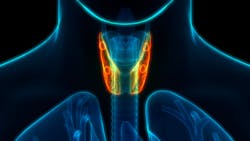A novel clinical trial from Cedars-Sinai Cancer shows that active surveillance is an effective treatment for many low-risk thyroid cancer patients. The study, published in JAMA Oncology, also showed for the first time that patients who opted for active surveillance experienced less anxiety than patients who underwent surgery.
Active surveillance is just that—actively surveying, or monitoring—a patient’s condition or disease with close imaging follow-up. If the cancer grows, physicians can still safely intervene with surgery.
While thyroid cancer diagnoses have escalated in recent decades, most are slow growing, lack symptoms and have survival rates of almost 100%. As such, efforts to curb this rise in incidence have led to guideline shifts in screening, diagnosis and staging.
The seven-year prospective clinical trial led by Cedars-Sinai Cancer aimed to not only evaluate how beneficial active surveillance is in treating the disease, but also to address patient anxiety associated with the diagnosis.
Of 222 patients enrolled in the study, 112 patients with tumors less than 20 millimeters in size underwent active surveillance and 110 opted for surgery.
To date, 90.1% of patients who enrolled in active surveillance remain on it, whereas 7.1% of patients eventually opted for surgery based on either personal preference or physician advice.
These findings, researchers said, shed light on the idea that the majority of patients with low-risk thyroid cancer who choose active surveillance can continue to undergo monitoring, knowing they may never need to undergo surgery.
The study also evaluated patient anxiety, comparing the level of worry for those who opted for active surveillance, versus those who opted for surgery.
Of the 222 patients enrolled in the clinical trial, 84 agreed to complete longitudinal anxiety surveys over time. Patients who underwent immediate surgery were found to have significantly higher anxiety scores than the patients who selected active surveillance.

